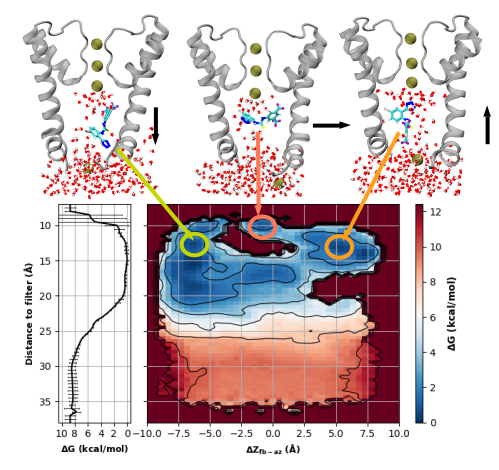Hydrophobic Dewetting in protein ion channels and model nanopores
Enhanced sampling of spontaneous dewetting in biologically-relevant model nanopores
How do some ion channels, such as the BK channel, have a gate despite the lack of a mechanical barrier?In nano-scale confined environments, water exists in a delicate equilibrium between condensed and vapor phase. We used simple model nanopores to study the effects of pore morphology and co-solvent concentration on the free energy cost of dewetting, in order to apply what I learn to real proteins like the BK channel. This work was done with an undergrad Samantha Schultz in Jianhan's lab. Read the paper here, and enjoy this pop-art we made of some snapshots of a nanopore dewetting for an image competition:

Certain BK pore mutations affect gating precisisely by changing hydrophobic dewetting
It was previously shown that the BK channel's gate is not a mechanical but a vapor barrier. BK channels can be activated by both membrane voltage and intracellular calcium binding. Intriguingly, the structures reveal that the inner pore remains wide-open in both activated and deactivated states. Combining atomistic simulations and experiments, we recently showed that BK channels contain a “hydrophobic gate”, where the inner pore desolvates and is impermeable to ions.
I applied a modified version protocol of the nanopore study to quantify how key inner pore mutations modulate the liquid-vapor equilibrium in the pore. You can read more about it in our paper. This project was selected in a special collection of the 20 Best Articles in the Biophysical Journal for 2023. Sometimes, we can even able to see a potassium ion permeating through the deep pore, as in the video below...
NS11021, BK channel activating compound, acts on vapor barrier to activate channel
In the third and final installment of my role in the BK hydrophobic dewetting saga at UMass Amherst, we showed showed a small molecule activator, NS11021, acts on the channel by entering the closed pore and stabilizing the hydrated state. Our extensive free energy analyses had two important pieces of experimental agreement: the overall binding affinity, and impressively, the magnitude of the affect on the intrinsic open probability of the closed pore. We showed this affect was dependent only on the molecule's presence in the pore; previously this molecules was believed to act via interactions with the filter and ions staged below the filter. You can read about this in our paper. This was the first time such a mechanism is proposed/defended.

